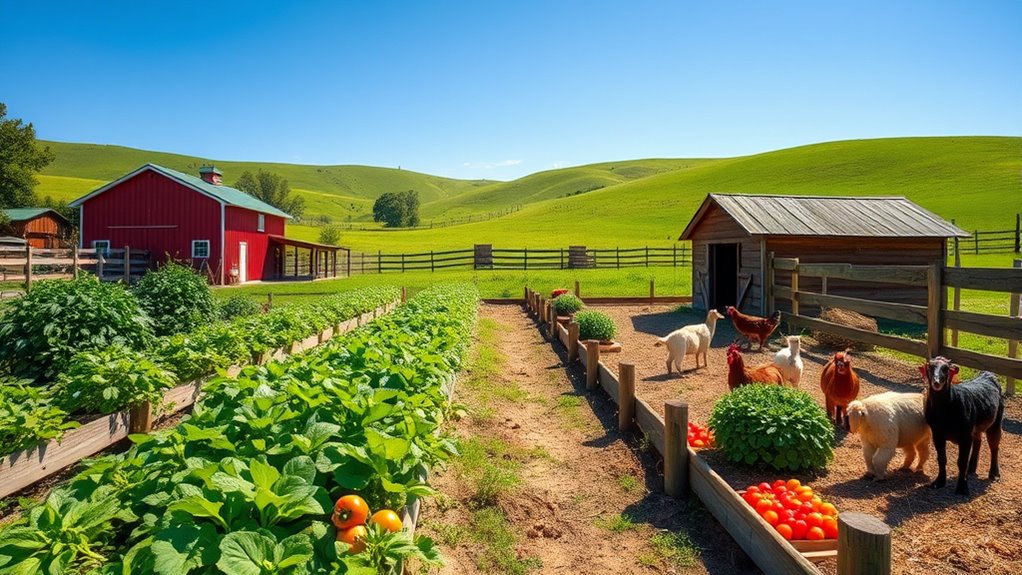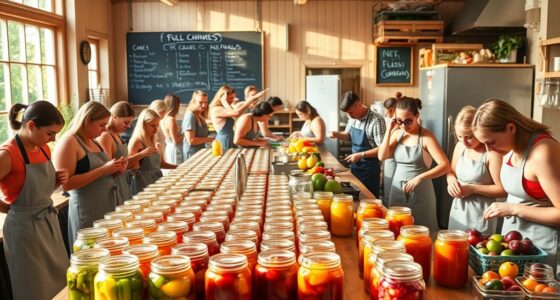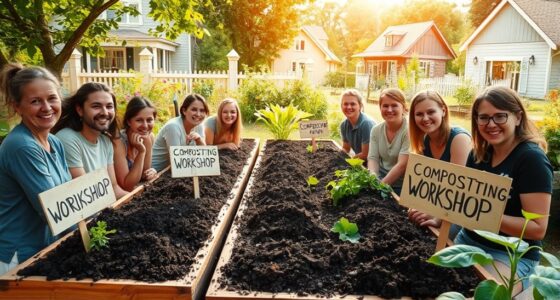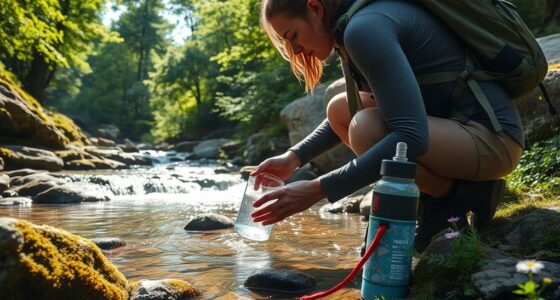To start homesteading for self-reliance, focus on selecting land with good sunlight, water access, and suitable topography. Grow resilient, nutrient-rich crops like root vegetables and leafy greens, using crop rotation and companion planting. Raise animals responsibly, ensuring proper nutrition and humane conditions. Manage soil with compost and cover crops, conserve water with rain barrels, and preserve your harvest through canning or freezing. Explore these basics further to build a sustainable, independent lifestyle.
Key Takeaways
- Select suitable land with good sunlight, water access, and natural features to support sustainable crop growth and livestock raising.
- Grow diverse, resilient crops using crop rotation and companion planting to ensure healthy soil and balanced nutrition.
- Provide proper shelter, nutrition, and humane handling for livestock, practicing organic and rotational grazing methods.
- Implement soil and water management techniques like composting, cover crops, rain harvesting, and mulching to conserve resources.
- Preserve harvests through canning, drying, and storing seeds properly to ensure year-round self-sufficiency.
Planning Your Homestead and Choosing the Right Location

Choosing the right location is essential for a successful homestead, and it starts with evaluating your goals and needs. Consider how permaculture principles can guide your land selection, emphasizing sustainable design and resource efficiency. Homestead zoning helps you organize different areas—like gardens, animal pens, and living spaces—based on their functions and requirements. Look for a site with good sunlight, access to water, and appropriate topography. Avoid areas prone to flooding or erosion. Think about future expansion and whether the land’s natural features support your vision. Planning with permaculture principles in mind ensures you create a resilient, productive environment. Proper zoning makes managing your homestead easier, helping you optimize space and resources from the start. Additionally, assessing the land’s potential for cost-effective development can help you stay within your budget and avoid unexpected expenses. Incorporating natural materials into your homestead design can further enhance sustainability and reduce costs over time. Considering the soil quality is also vital, as it influences the success of your crops and overall land health. You might also explore edible plants like chia seeds that can be cultivated to diversify your food sources and promote self-reliance.
Selecting and Growing Nutritious, Adaptable Crops

Selecting the right crops is essential for a resilient and productive homestead, especially when focusing on nutritious and adaptable varieties. To maximize yields and maintain soil health, practice crop rotation, which helps prevent pests and disease buildup. Incorporate companion planting to boost plant health and improve flavor—pair beans with corn, for example, to enhance growth and provide mutual benefits. Choose crops suited to your climate and soil conditions, prioritizing varieties that are hardy, nutrient-dense, and easy to grow. Mix root vegetables, leafy greens, and legumes to diversify your harvest and ensure a balanced diet. Be aware of signs of spoilage in stored produce to minimize waste and ensure food safety. By thoughtfully selecting crops and using techniques like crop rotation and companion planting, you set a strong foundation for a sustainable, self-reliant homestead.
Raising Livestock Safely and Sustainably

After establishing healthy, adaptable crops, it’s equally important to focus on raising livestock in ways that are both safe and sustainable. Prioritize animal welfare by providing clean, spacious living conditions and proper nutrition. Use organic farming principles to reduce chemical use, guaranteeing your animals are healthier and your land remains fertile. Implement rotational grazing to prevent overgrazing and soil degradation, supporting long-term sustainability. Regular health checks and humane handling protect your livestock and promote ethical practices. Avoid overcrowding and ensure access to fresh water, fostering stress-free environments. Additionally, selecting appropriate fencing materials helps keep your animals secure and reduces stress. Incorporating animal health monitoring practices and sustainable land management techniques creates a balanced system that benefits your livestock, your land, and your self-reliance goals.
Managing Soil Health and Water Resources

To maintain healthy soil and guarantee your water resources remain sustainable, you need to actively manage both with intentional practices. Start by conducting soil testing to understand nutrient levels and pH balance; this helps you apply the right amendments and avoid over-fertilizing. Incorporate cover crops and composting to improve soil structure and boost fertility naturally. For water conservation, install rain barrels and drip irrigation systems to reduce waste. Mulching around plants minimizes evaporation and keeps soil moist. Avoid unnecessary watering and schedule irrigation during cooler parts of the day. Regularly monitor your water sources to prevent contamination and ensure sustainability. Additionally, understanding soil health principles can guide you in maintaining productive and resilient land. By staying proactive with soil testing and water conservation, you’ll create a resilient homestead environment that supports healthy plants and conserves resources. Incorporating water-efficient practices can further enhance your resource management efforts. Applying best management practices for water and soil helps sustain your homestead long-term. Emphasizing regenerative agriculture techniques can also promote ecosystem health and soil vitality over time. Moreover, adopting conservation techniques can help preserve water quality and availability for future generations.
Maintaining a Self-Sufficient Lifestyle Through Preservation and Storage

Maintaining a self-sufficient lifestyle hinges on effective preservation and storage methods that keep your harvests fresh and nutritious long after harvest time. Food preservation techniques like canning, drying, and freezing help extend shelf life, while seed saving ensures future planting success. Proper storage conditions protect your crops from pests and spoilage, saving you money and effort. Keep your seeds dry and cool to maintain viability for next season, which is crucial for seed viability. Use airtight containers for preserved foods to prevent contamination. Regularly check stored items and rotate stock to prevent waste. By mastering these methods, you’ll enjoy a steady supply of fresh produce and seeds, reducing reliance on stores and fostering true self-reliance. Additionally, choosing the right storage environment can significantly influence the longevity of your preserved foods and seeds. Here’s a quick overview:
| Preservation Method | Storage Tip |
|---|---|
| Canning | Use sterilized jars |
| Drying | Keep in a cool, dry place |
| Freezing | Use airtight containers |
| Seed Saving | Store in a dry, dark spot |
| Food Preservation | Label with date |
Frequently Asked Questions
How Do I Start Homesteading With Limited Space?
If you want to start homesteading with limited space, focus on urban gardening and container farming. You can transform small balconies, patios, or windowsills into green spaces by using containers for vegetables, herbs, and even small fruit plants. Maximize vertical space with wall planters or hanging baskets. This approach lets you grow food efficiently, build self-reliance, and enjoy fresh produce without needing a large yard.
What Are the Best Beginner-Friendly Livestock Options?
If you’re new to urban farming, start with beginner-friendly livestock like chickens or rabbits. They require minimal space and are easier to care for, making them ideal for small setups. Chickens give you eggs and help control pests, while rabbits provide meat and manure for composting. Focus on proper livestock care, including secure housing and regular feeding, to guarantee your animals thrive and your urban farm stays sustainable.
How Can I Prevent Pests Without Chemicals?
Ever wondered how to keep pests at bay without chemicals? You can encourage natural predators like ladybugs and birds to control pests naturally. Additionally, practicing companion planting creates a balanced ecosystem, where certain plants repel pests or attract beneficial insects. Are you ready to create a thriving, chemical-free garden? By integrating these methods, you’ll promote healthy growth and protect your crops sustainably.
What Are Low-Cost Methods for Preserving Harvests?
To preserve your harvest cost-effectively, try solar dehydration to dry fruits and vegetables naturally, saving energy and money. You can also use fermenting techniques like sauerkraut or pickles, which require minimal equipment and promote probiotics. Both methods extend your harvest’s shelf life without chemicals, keeping your food fresh and nutritious. These affordable, sustainable options help you maximize your harvest while maintaining a self-reliant lifestyle.
How Do I Manage Homestead Finances Effectively?
Think of your finances as a garden where careful planning is the water that helps everything flourish. To manage it effectively, you need to focus on budget planning, ensuring your expenses don’t overrun your income. Diversify your income sources to create a resilient financial ecosystem. Regularly review your spending, set savings goals, and adapt your plans as your homestead grows. This approach keeps your financial garden healthy and thriving.
Conclusion
As you nurture your homestead, remember that patience and dedication are your best guides. With each seed planted and every animal cared for, you’re gently weaving a resilient tapestry of self-reliance. Embrace the quiet wisdom of nature’s rhythms, and trust that your efforts will bloom into a sustainable haven. In time, your journey becomes a subtle dance with the land, revealing the true richness of a life rooted in simplicity and care.










